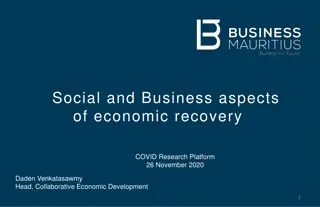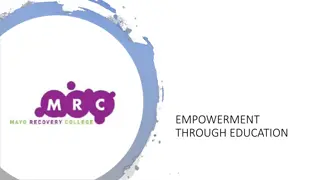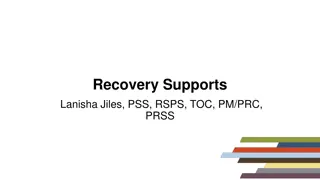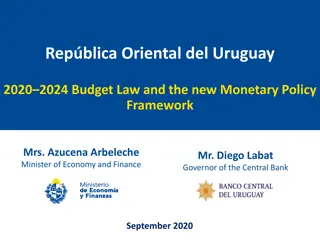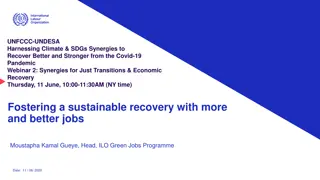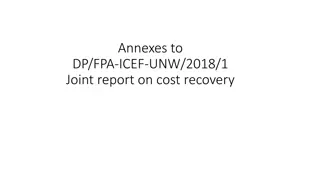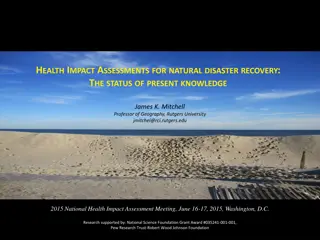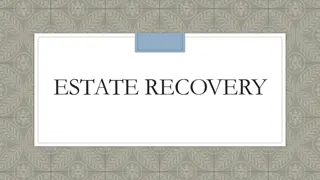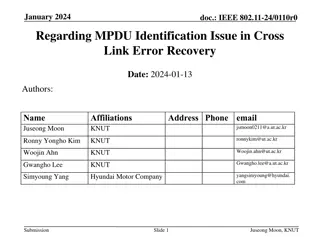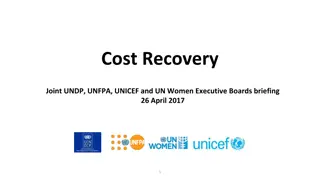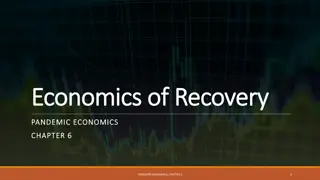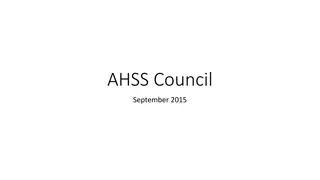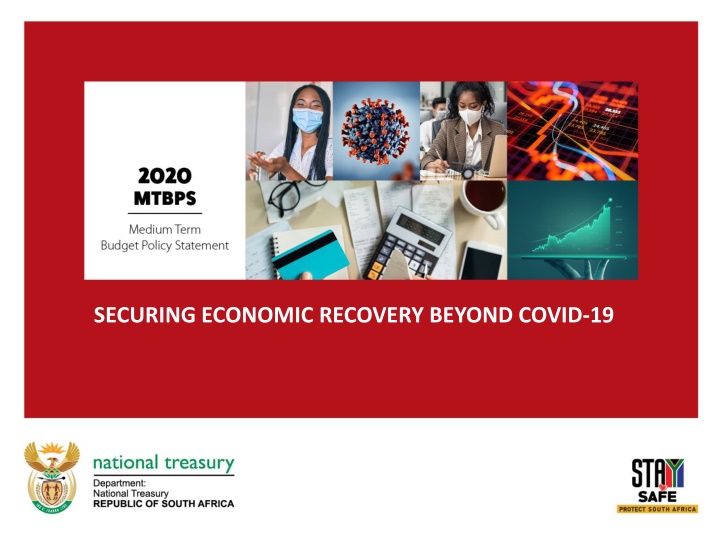
Securing Economic Recovery Beyond COVID-19 Overview
Government's medium-term policy priorities focus on economic recovery and fiscal consolidation following the impact of COVID-19. Economic growth projections, fiscal measures, and global economic recovery expectations are discussed in detail. The domestic economic outlook for South Africa highlights key macroeconomic projections and risks to the economic landscape.
Download Presentation

Please find below an Image/Link to download the presentation.
The content on the website is provided AS IS for your information and personal use only. It may not be sold, licensed, or shared on other websites without obtaining consent from the author. If you encounter any issues during the download, it is possible that the publisher has removed the file from their server.
You are allowed to download the files provided on this website for personal or commercial use, subject to the condition that they are used lawfully. All files are the property of their respective owners.
The content on the website is provided AS IS for your information and personal use only. It may not be sold, licensed, or shared on other websites without obtaining consent from the author.
E N D
Presentation Transcript
Overview Government s medium-term policy priorities are economic recovery and fiscal consolidation. The social compact agreed to between government, business, labour and civil society prioritises short-term measures to support the economy, alongside crucial structural economic reforms. The economy is expected to contract by 7.8 per cent in 2020, recovering to real GDP growth of 3.3 per cent in 2021. Economic growth is expected to average 2.1 per cent over the three-year forecast period. Fiscal measures primarily reductions to the wage bill will narrow the budget deficit and stabilise debt over the next five years to return the public finances to a sustainable position. The consolidated deficit narrows from 15.7 per cent of GDP in 2020/21 to 7.3 per cent by 2023/24. Gross national debt is projected to stabilise at 95.3 per cent of GDP by 2025/26. 1
Global economic recovery is expected to be long and uneven Table 2.1 Economic growth in selected countries Region/country 2018 2019 2020 Projections 2021 2020 2021 Difference from June 2020 Projections Percentage World Advanced economies United States Euro area United Kingdom Japan Emerging and developing countries China India Brazil Russia Sub-Saharan Africa Nigeria South Africa1 World trade volumes 1National Treasury forecasts Source: IMF World Economic Outlook, October 2020 Actual 3.5 2.2 3.0 1.8 1.3 0.3 4.5 2.8 1.7 2.2 1.3 1.5 0.7 3.7 -4.4 -5.8 -4.3 -8.3 -9.8 -5.3 -3.3 5.2 3.9 3.1 5.2 5.9 2.3 6.0 0.8 2.3 3.7 1.9 0.4 0.5 -0.2 -0.2 -0.9 -1.4 -0.8 -0.4 -0.1 0.2 6.7 6.1 1.3 2.5 3.3 1.9 0.8 3.9 6.1 4.2 1.1 1.3 3.2 2.2 0.2 1.0 -10.3 -5.8 -4.1 -3.0 -4.3 -7.8 -10.4 1.9 8.2 8.8 2.8 2.8 3.1 1.7 3.3 8.3 0.9 -5.8 3.3 2.5 0.2 1.1 -0.6 1.5 2.8 -0.8 -1.3 -0.3 -0.9 0.4 0.3 Containment of COVID-19 is expected to support an improving growth outlook in advanced economies in 2021. Developing countries are set to grow faster than their developed counterparts next year. 2
Domestic economic outlook Table 1.1 Macroeconomic projections 2019 Actual 2020 Estimate 2021 2022 Forecast 2023 Calendar year Percentage change unless otherwise indicated Household consumption Gross fixed-capital formation Real GDP growth GDP at current prices (R billion) CPI inflation Current account balance (% of GDP) Source: Reserve Bank and National Treasury 1.0 -0.9 0.2 5 078 -3.0 -7.9 -19.6 -7.8 4 885 -0.8 4.7 -1.4 3.3 5 240 -1.6 5 553 -2.0 2.2 3.9 1.7 5 877 -2.7 1.9 3.9 1.5 4.1 3.2 4.1 4.4 4.5 Following a sharp, synchronised 2020 COVID-19 recession, SA real GDP growth will average 2.1 per cent over the medium term, with output only returning to pre- pandemic levels in 2024. The main risks to the economic outlook are weaker-than-expected growth, continued deterioration in the public finances and a failure to implement structural reforms. A second wave of COVID-19 infections, accompanied by new restrictions on economic activity, would have significant implications for the outlook. 3
The COVID-19 fiscal relief package Main budget non-interest spending increased by R36 billion in the current year compared with 2020 Budget estimates, including COVID-19 fiscal relief package allocations to critical frontline services. The state s contingent liabilities increased through a R200 billion credit guarantee scheme for firms. In addition, the June 2020 special adjustments budget made provision for additional tax relief of R70 billion and temporary unemployment relief of R40 billion. By the end of September, R47.4 billion had been paid to 10.6 million beneficiaries from over 931 000 employers through the temporary employer/employee relief scheme. The Reserve Bank has also provided support to households and firms by lowering the main interest rate (the repurchase rate) by 2.75 percentage points since March 2020. Details on the take-up and effects of tax relief measures will be provided in the 2021 Budget Review. 4
The economic recovery plan Working with its social partners in business, labour and civil society, government has begun implementing an economic recovery plan, with immediate measures to boost confidence and investment, and longer-term reforms to promote sustained higher economic growth. In the short term, the economic recovery plan will focus on building infrastructure, expanding electricity generation, allocating digital spectrum, and supporting rapid industrialisation and employment. At the same time, government will roll out structural reforms such as modernising network industries, reducing barriers to entry, and increasing regional integration and trade. The National Treasury estimates that, in combination, these reforms can raise growth to over 3 per cent over the next 10 years and create more than 1 million jobs. The Infrastructure Fund will complement the plan s focus on capital investments. Operation Vulindlela implementation unit will be staffed by a full-time technical team that draws on additional expertise and capacity in the public and private sectors. 5
Revenue outlook Table 3.4 Revised revenue projections R billion 2020 Budget Buoyancy 2020 special adjustments budget Buoyancy Revised estimates Buoyancy 2020/21 1 425.4 0.93 1 121.3 3.23 1 112.6 3.18 -312.8 -8.7 2021/22 1 512.2 1.00 1 291.4 1.58 1 279.5 1.59 -232.7 -11.9 2022/23 1 609.7 1.01 1 394.0 1.46 1 392.2 1.50 -217.5 -1.8 2023/24 1 508.9 1.33 1 503.2 1.35 Change since 2020 Budget Change since 2020 special adjustments budget Source: National Treasury -5.7 The extraordinary shock to economic output in 2020/21 translates into large revenue shortfalls that will persist over the medium term. Although overall buoyancies appear relatively large up until the end of the MTEF period, this reflects a slow improvement in the tax-to-GDP ratio after the large once-off decrease in 2020/21. The tax-to-GDP ratio is only expected to recover to the 2019/20 level by 2027/28. 6
South Africa in global context Average primary balance, 2009 2019 Projected three-year increase in debt 2 Pakistan Uruguay Egypt Per cent of GDP 1 Belarus Hungary Malaysia 0 Croatia Morocco Sri Lanka -1 Ukraine Peru Dominican Republic -2 Poland Chile -3 Brazil Turkey Thailand -4 Colombia India India Brazil Dominican Rep. Peru Malaysia Philippines Chile Hungary Belarus Pakistan South Africa Turkey Ukraine Sri Lanka Egypt Poland Croatia Morocco Colombia Thailand China Uruguay Philippines China South Africa -5 0 5 10 15 20 25 Per cent of GDP Source: IMF Fiscal Monitor, October 2020 In comparison with a wide range of other developing countries, South Africa s average primary balance over the last 10 years falls in the middle of the distribution. But South Africa s three-year increase in debt to GDP is the among the largest. Fiscal distress is mounting in developing countries amid historically high indebtedness. In this environment of rising fiscal pressures, South Africa is losing ground to its peers. 7
Fiscal metrics are deteriorating Over the past five years, the fiscal environment has been characterised by: Interest payments absorbing a growing share of limited public resources, which increasingly crowds out spending on social and economic investment. Debt-service costs are now 4.8 per cent of GDP, up from 3.3 per cent in 2016/17. A sharp drop in public infrastructure investment, mostly driven by declines in spending by state-owned companies. Between 2016/17 and 2019/20, total public infrastructure spending fell from R250 billion to R183 billion, or from 5.7 to 4 per cent of GDP. A deteriorating government balance sheet, including state-owned companies and municipalities struggling to pay salaries and other operational costs. Options to stabilise the fiscus are becoming increasingly limited. Growth reforms are only expected to begin yielding results over the next several years, implying continued weakness in revenue collection over the period ahead. 8
Proposed steps to reduce the fiscal deficit and stabilise the debt-to-GDP ratio over a five-year period Relative to the 2020 Budget, main budget non-interest spending (excluding technical adjustments) is reduced by R60 billion in 2021/22, R90 billion in 2022/23 and R150 billion in 2023/24, with constrained spending growth in the following two years. The largest share of reductions falls on compensation. Other non-interest spending items are also reduced, while funding for buildings and other fixed structures, provincial and local capital grants, and the Infrastructure Fund is protected. To assist with the consolidation, government has projected tax increases of R5 billion in 2021/22, R10 billion in 2022/23, R10 billion in 2023/24 and R15 billion in 2024/25. The aim is to reach a main budget primary surplus by 2025/26. This target is expected to result in debt stabilising at 95.3 per cent of GDP in the same year. 9
The main budget and primary balances will narrow over the medium term Main budget primary balance* Main budget deficit 31 16 Main budget revenue Interest payments Primary deficit 30 14 9.8 Main budget non-interest expenditure 29 12 Per cent of GDP 28 Per cent of GDP 10 5.0 27 8 3.0 26 1.4 6 2.7 25 4.1 2.4 2.22.31.6 1.31.00.51.01.0 4 24 2.2 2.3 2.5 2.7 2.8 3.0 3.1 3.3 3.5 3.7 4.04.85.15.6 5.9 23 2 22 0 2006/07 2007/08 2008/09 2009/10 2010/11 2011/12 2012/13 2013/14 2014/15 2015/16 2017/18 2018/19 2019/20 2020/21 2021/22 2022/23 2023/24 2016/17 2009/10 2010/11 2011/12 2012/13 2013/14 2014/15 2015/16 2016/17 2017/18 2018/19 2019/20 2020/21 2021/22 2022/23 2023/24 *Excludes Eskom financial support and transactions in financial assets and liabilities 10
Gross loan debt outlook 100 95.3 95.1 94.6 94.5 95 93.3 92.9 90.1 90 85.6 85 81.8 Per cent of GDP 80 75 70 65 63.3 60 56.6 55 53.0 50.5 50 2016/17 2017/18 2018/19 2019/20 2020/21 2021/22 2023/24 2024/25 2025/26 2026/27 2027/28 2028/29 2022/23 11
Fiscal framework Table 1.2 Consolidated government fiscal framework 2019/20 Outcome 1 518.1 2020/21 Revised 1 276.7 2021/22 2022/23 2023/24 Medium-term estimates 1 595.8 27.4% 1 993.5 37.5% -535.9 -10.1% 4 551.8 85.6% R billion/percentage of GDP Revenue 1 457.6 1 705.7 28.6% 2 139.2 35.9% -433.4 -7.3% 5 536.2 92.9% 29.5% 1 848.7 35.9% -330.6 -6.4% 3 261.3 63.3% 26.3% 2 037.8 41.9% -761.1 -15.7% 3 974.1 81.8% 28.3% 2 079.6 36.9% -483.9 -8.6% 5 071.3 90.1% Expenditure Budget balance Total gross loan debt Source: National Treasury The consolidated deficit includes national and provincial government, social security funds and public entities. The consolidated deficit will narrow from 15.7 per cent of GDP in 2020/21 to 10.1 per cent in 2021/22 and 7.3 per cent by the outer year. 12
The proposed spending reductions will improve the composition of spending from consumption towards investment Average nominal consolidated spending growth, 2020/21 2023/24* 7.8 Payments for capital assets 3.0 Provinces and municipalities 2.5 Goods and services 2.3 Households 0.8 Compensation of employees Departmental agencies and accounts -0.7 -2 0 2 4 6 8 Per cent *Excludes COVID-19 fiscal relief measures in 2020/21 13
Achieving wage bill reductions Government proposes growth in the public-service wage bill of 1.8 per cent in the current year and average annual growth of 0.8 per cent over the 2021 MTEF period. Government has not implemented the third year of the 2018 wage agreement. Notwithstanding that the matter is before the labour court, government is actively engaging with labour unions to find a solution to a more sustainable cost of employment. Furthermore, the Budget Guidelines propose a wage freeze for the next three years. Additional options to be explored include harmonising the allowances and benefits available to public servants, reconsidering pay progression rules and reviewing occupation-specific dispensations. 14
Fastest-growing functions Consolidated government expenditure by function, 2021/22 2023/24 Economic development and community development are the fastest-growing functions mainly due to above- inflation growth in road infrastructure and expanded access to basic services in line with economic recovery plan 15
Risks to the fiscal outlook The major short- to medium-term risks to the fiscal framework include: Uncertainty around the speed of the economic recovery including the medium- term effects of the lockdown, both domestically and internationally. Globally, several developed economies have returned to strict lockdowns. Implementation risks for expenditure reductions, particularly on the wage bill. Both the upcoming decision on the final year of the current wage agreement and the upcoming wage talks pose significant risks to the expenditure ceiling. Additional spending pressures from state-owned companies. Several companies, including South African Airways, are insolvent and have insufficient funds to cover operational expenses. 16
Conclusion Government remains committed to closing the budget deficit and stabilising the national debt-to-GDP ratio. A combination of expenditure and revenue measures will narrow the main budget deficit from 14.6 per cent of GDP in 2020/21 to 7.3 per cent by 2023/24. Gross national debt is projected to stabilise at 95.3 per cent of GDP by 2025/26. Achieving these targets will require large reductions in non-interest spending over the next three years. The majority of these reductions will be applied to the wage bill. Government will aim to protect funding for infrastructure investment. To assist with the consolidation, government has projected tax increases of R5 billion in 2021/22, R10 billion in 2022/23, R10 billion in 2023/24 and R15 billion in 2024/25. Learning and culture receives the largest funding allocation, while economic development and community development are the fastest-growing functions. 17
What is the ERRP? Developed through extensive consultation between social partners, the Economic Recovery and Reconstruction Plan (ERRP) targets short-term measures alongside crucial structural reforms to raise both short- and long-term growth In the short term the plan aims to: Rebuild investor, consumer and public confidence; Kick-start the economy; and Continue to provide relief to mitigate the impact of the Covid-19 pandemic In the medium term, the plan will put the economy on a higher and more inclusive growth path through the implementation of a set of structural reforms that will enable faster, more inclusive growth and employment over the medium to long term. Many of these reforms are drawn from government s long-term structural reform agenda as outlined in the Economic Transformation, Inclusive Growth, and Competitiveness: A Contribution Towards a Growth Agenda for the South African Economy document. Reforms to modernise network industries, reduce barriers to entry, facilitate regional trade and integration, promote labour-absorbing sectors, and re-imagine our industrial policy are cornerstones of government s growth strategy.
ERP raises growth to over 3% by 2030 *Agriculture and industrial initiatives ** Reducing barriers to entry, easing the skills constraint, and implementing tourism initiatives
What is at stake GDP level GDP growth If no reforms are enacted, GDP growth remains below 2 per cent over the medium term At these growth rates the level of GDP only reaches 2019 levels by 2028 This means that per capita GDP will not increase and unacceptably high unemployment levels will persist
Operation Vulindlela Despite being required for economic growth, and being of keen interest to the public, social partners at Nedlac and the investor community, implementation of structural reforms has been slow. Operation Vulindlela is a joint initiative between the Presidency and the National Treasury to fast-track priority structural reforms. OV draws on lessons from previous initiatives such as Operation Phakisa, as well as international experience of delivery units in that it focuses on a limited number of priority reforms and the President plays a key role. The objective of OV is to support the Cluster, Cabinet, National Economic Recovery Council and President to ensure that approved priority structural reforms are implemented efficiently, effectively and expeditiously. It does not take away responsibility for implementing reforms from reform implementers; reform implementing Ministers remain accountable for implementation of reforms for which they are responsible in some cases, this responsibility and accountability is enshrined in law. Instead, the small dedicated Vulindlela unit (which draws on additional expertise from public and private sectors as required) helps by monitoring progress, engaging with reform implementers, escalating challenges, and providing support to fast-track implementation.
Progress on key reforms Energy: Issuance of Request for Proposals (RFP) of 2000MW of emergency power for the emergency Risk Mitigation Independent Power Producers Procurement Programme (RMIPPPP) on 21 August 2020. Projects are expected to be fully operational no later than June 2022. In September 2020 NERSA provided its concurrence to Section 34 Ministerial Determination issued in February, which opened the way for the procurement of 11 813 MW of new electricity capacity, including: 6 800MW to be generated from renewable energy sources. The DMRE has indicated that the RFP for Bid Window 5 should launch by December 2020. Transport: The Economic Regulation of Transport Bill, which allows for third party access into the rail sector, was approved by Cabinet in November 2019 and currently before the Transport Committee of the National Assembly. Transnet has established a Port of Durban Decongestion Task Team. The Task Team has implemented various measures, including; the use of new equipment, improved access roads leading to the port, increased workforce and port operating hours, training of gantry crane operators and a truck booking system. Transnet noted that they were engaging various stakeholders around corporatisation of TNPA (in line with the National Ports Act) and expect the process to be finalised by the end of the 2020/2021 financial year. Spectrum: In response to the National State of Disaster, the regulator introduced the temporary licensing of high demand spectrum to ensure the sector could meet increased demand for ICT services. This spectrum is valid until the March 2021 (previously November 2020). In terms of licensing spectrum on a permanent basis, the regulator has released the invitations to apply (ITA) for (i) the International Mobile Telecommunications (IMT) (high demand spectrum), and (ii) the Wireless Open Access Network (WOAN). The spectrum is expected to be auctioned by March 2021.





